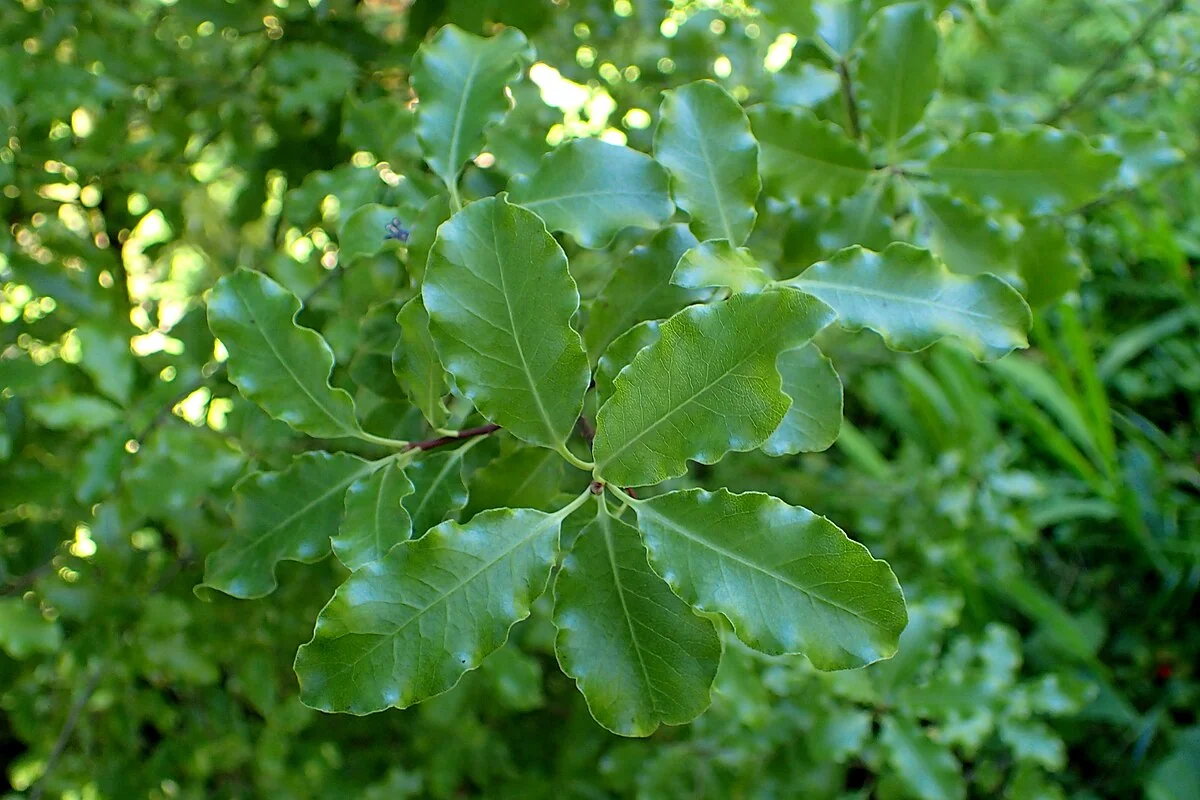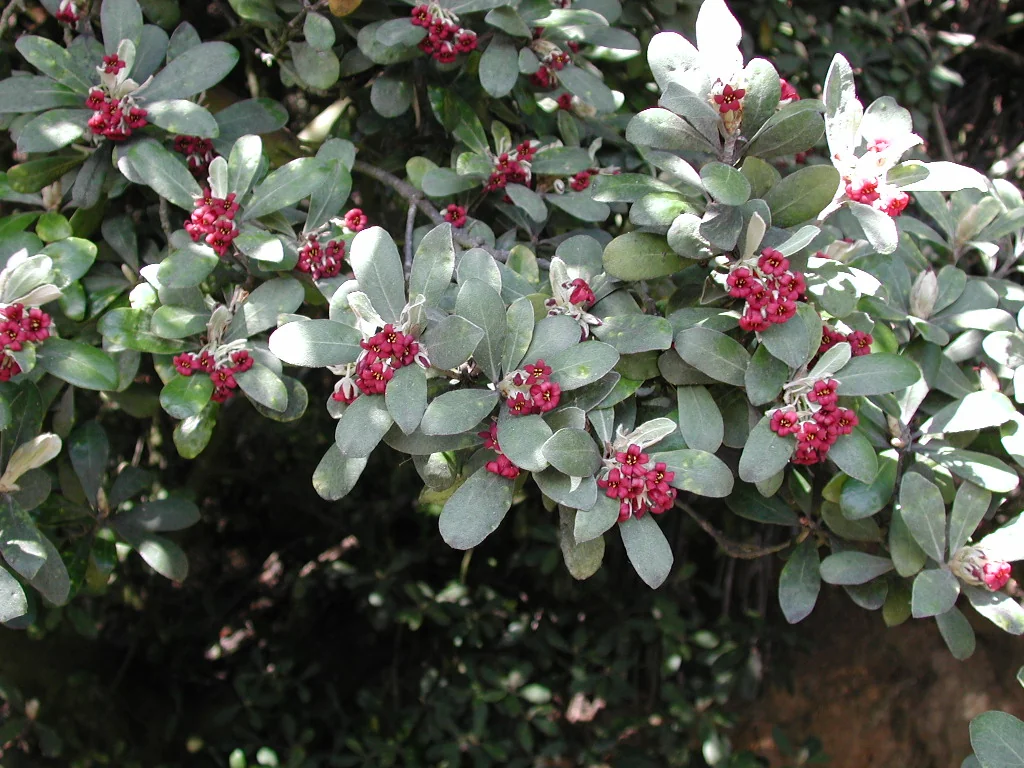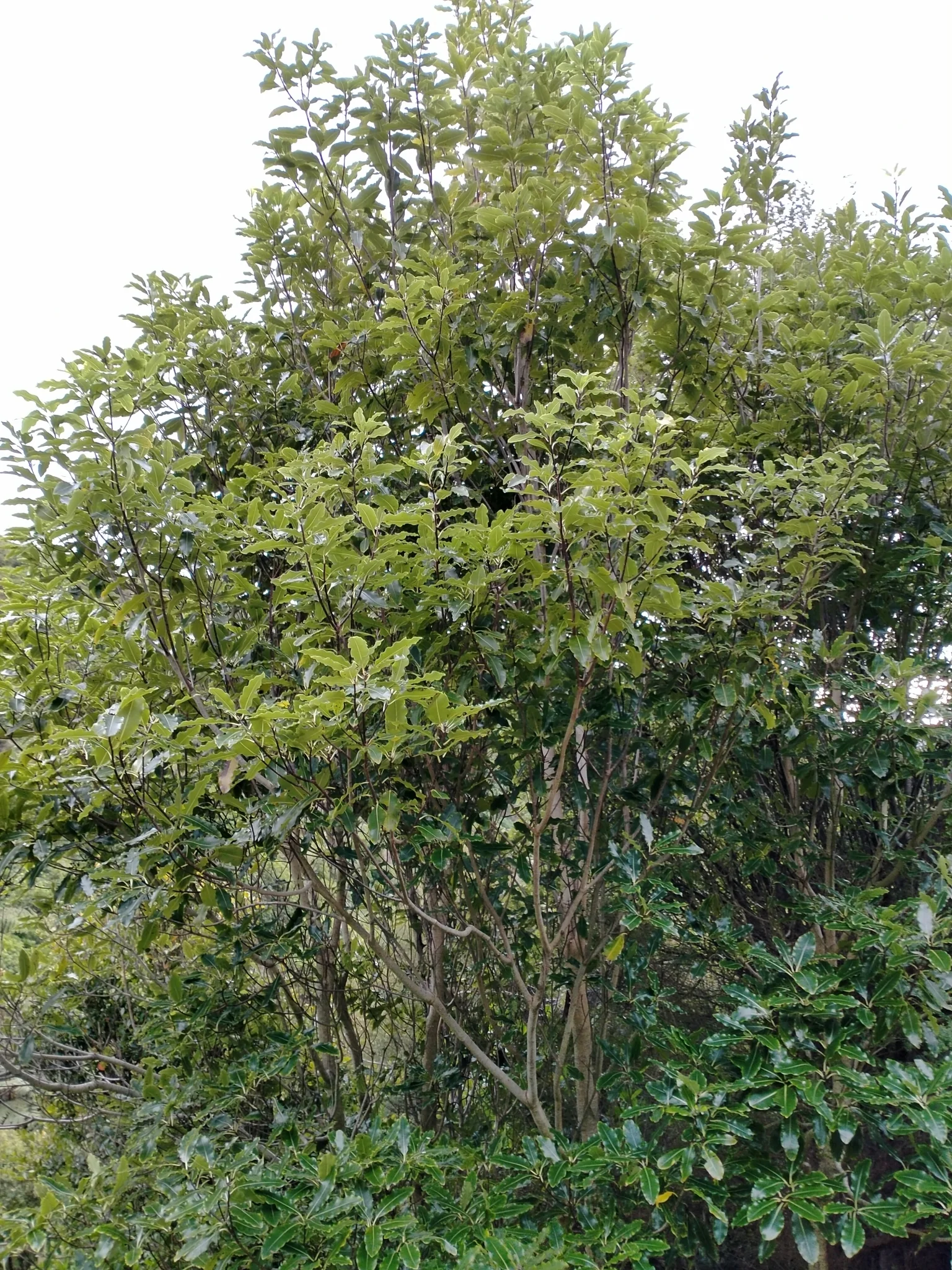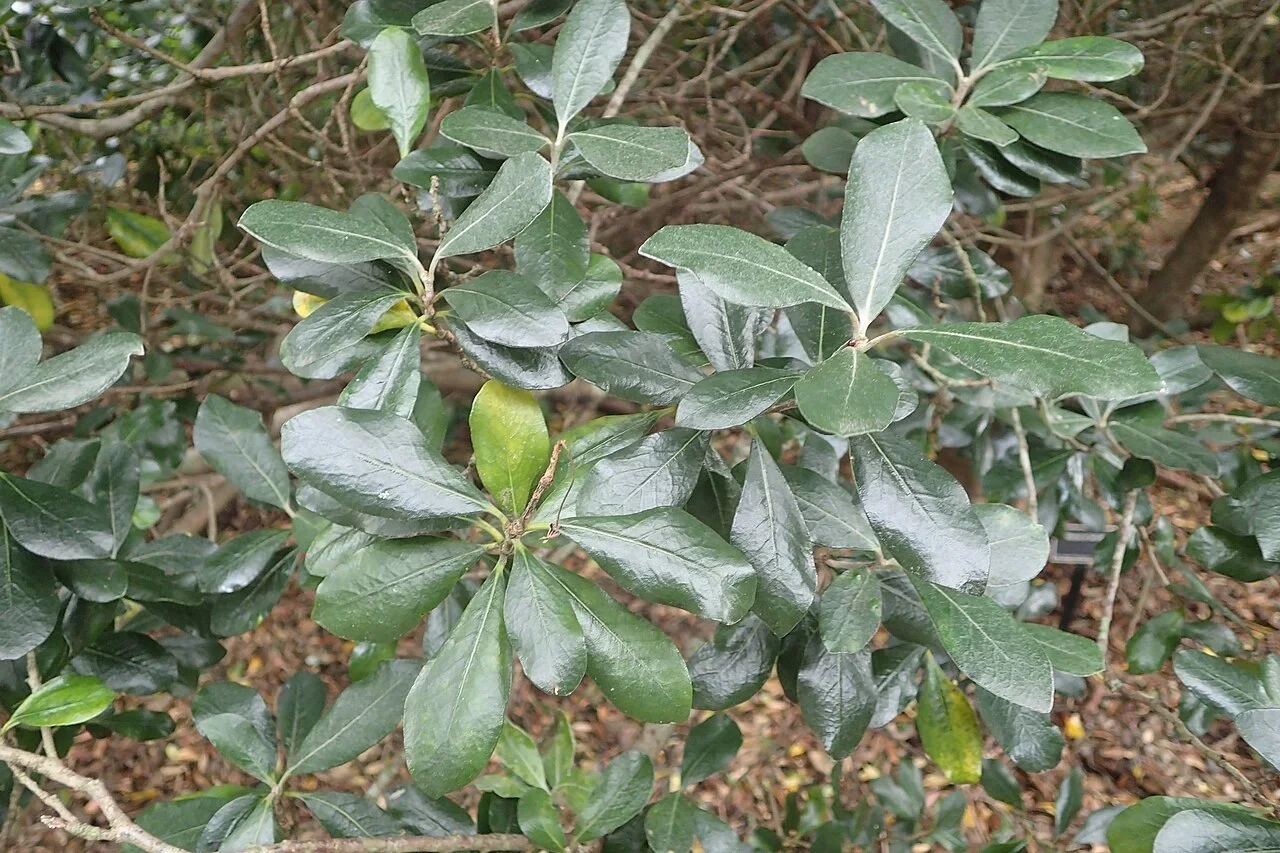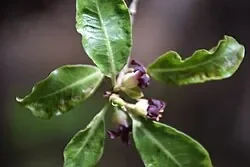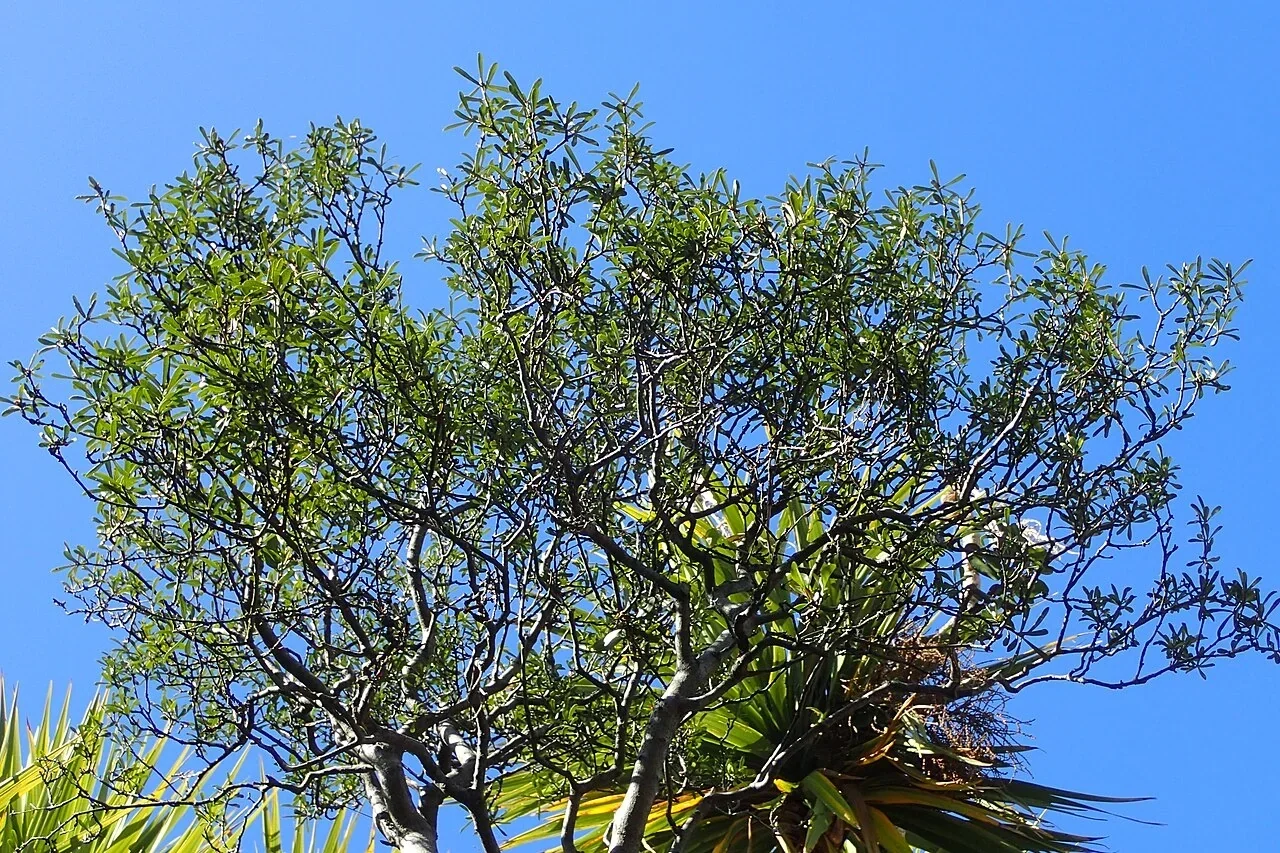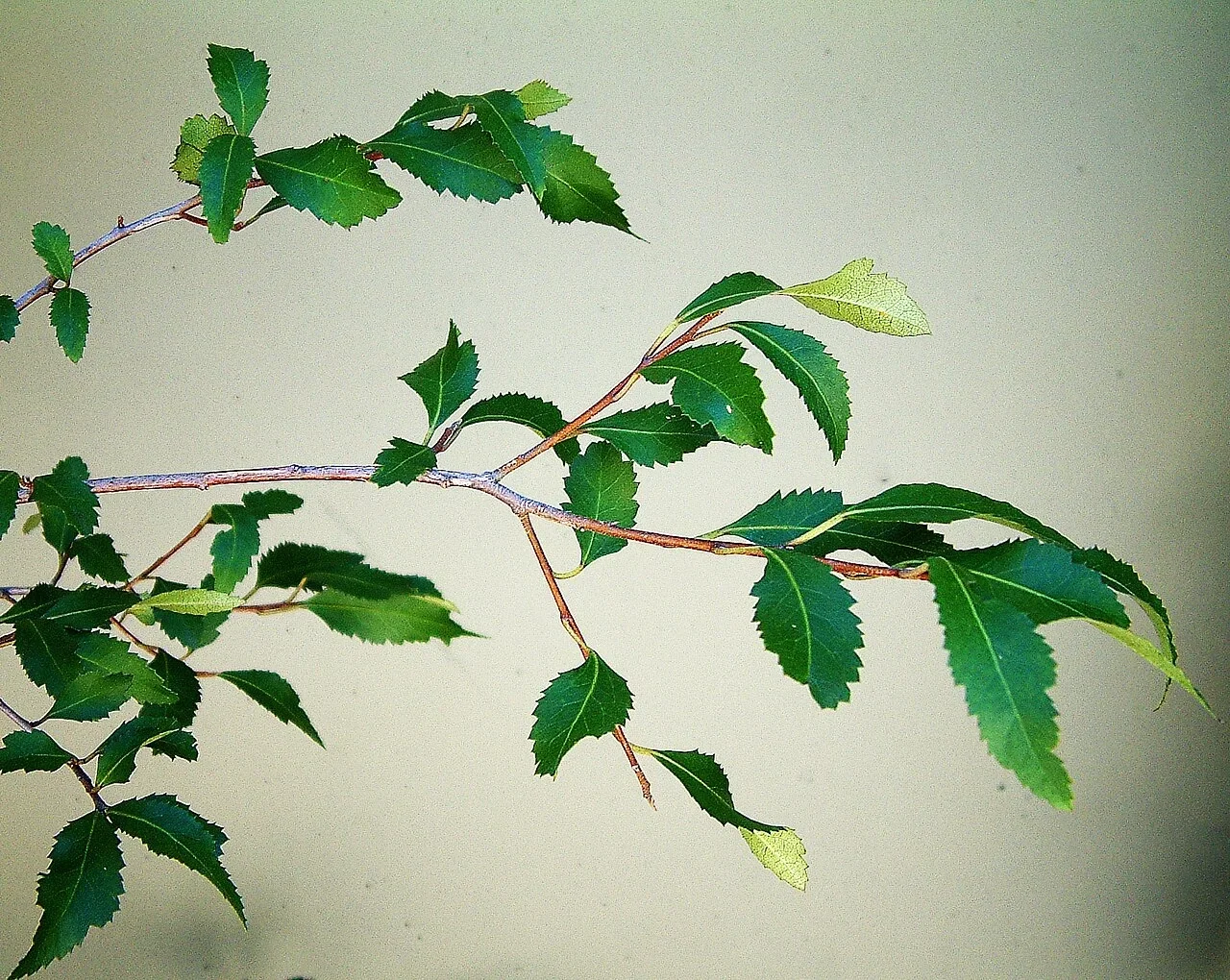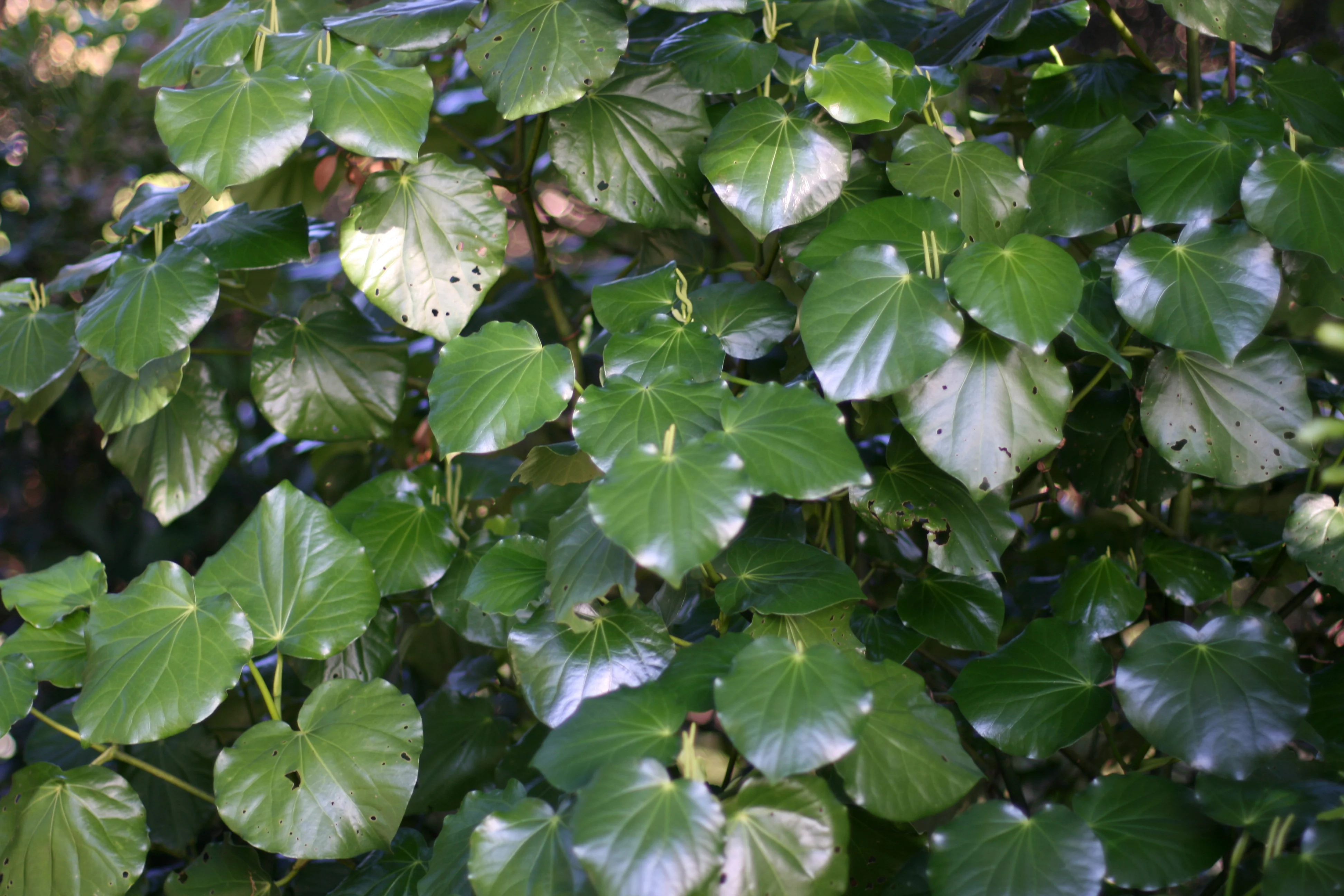
Kawakawa
Piper excelsum
Kawakawa (Piper excelsum) is one of New Zealand's most significant cultural plants, revered as a taonga (treasure) by Māori for over 700 years. This endemic shrub belongs to the pepper family (Piperaceae) and is instantly recognizable by its large, heart-shaped leaves with distinctive holes caused by the kawakawa looper moth. Beyond its striking appearance, kawakawa holds profound importance in rongoÂā (Māori traditional medicine) and continues to be validated by modern scientific research for its remarkable healing properties.

Plant Description
Botanical Features
Kawakawa (Piper excelsum), also known as New Zealand peppertree, is a small tree or densely branched shrub belonging to the pepper family (Piperaceae). It typically grows up to 6 meters tall, or a densely branched shrub. The leaves are a distinctive feature, being large (5-10 cm long by 6-12 cm wide), heart-shaped, broadly rounded with a short tip, and often glossy. They are deep green in forest environments but can be yellowish-green in more open areas. A common characteristic is the presence of holes in the leaves, caused by the kawakawa looper moth caterpillar. The stems are fleshy, green, and have noticeable swollen or knobbly joints (nodes), giving the plant a unique "jointed" appearance. Minute flowers are produced on greenish, erect spikes, typically 2.5-7.5 cm long. Male and female flowers are often found on separate plants. After pollination, the flowers develop into small, berry-like fruits that are yellow to bright orange. These fruits are edible and serve as a food source for birds.
Quick Facts
| Scientific Name | Piper excelsum |
|---|---|
| Height | 2-6 m |
| Spread | 2-5 m |
| Water Needs | Moderate, drought tolerant when established |
| Light | Dappled light to partial shade |
| Frost Tolerance | Frost tender |
| Salt Tolerance | Moderate |
| Growth Rate | Fast |
| Lifespan | Long |
Climate Best Suited to
Kawakawa (Piper excelsum) is naturally distributed from Te Paki in the far north to North Canterbury and Banks Peninsula in the south, thriving in coastal to lowland areas up to 500 metres elevation. As a cold-sensitive species, kawakawa cannot tolerate frost and prefers the warmer, more humid conditions found in its natural range. It flourishes in sheltered locations with consistent moisture and protection from harsh winds and extreme temperatures.
Regional Suitability
| City | Climate Suitability |
|---|---|
| Whangārei | Ideal |
| Auckland | Ideal |
| Hamilton | Ideal |
| Tauranga | Ideal |
| Rotorua | Good |
| Gisborne | Ideal |
| New Plymouth | Good |
| Napier | Good |
| Whanganui | Good |
| Palmerston North | Good |
| Wellington | Good |
| Nelson | Good |
| Christchurch | Moderate |
| Dunedin | Challenging |
| Invercargill | Challenging |
Natural Habitat
Kawakawa (Piper excelsum) is a small tree or densely branched shrub endemic to New Zealand, found throughout the North Island, the northern parts of the South Island, and on the Chatham Islands. It thrives in coastal to lowland forests, typically at elevations up to 500 meters above sea level.
Preferred Conditions:
- Sheltered and Moist: Kawakawa prefers sheltered locations with consistent moisture and protection from harsh winds and extreme temperatures. It is often found in the understory of forests, along stream banks, and in damp gullies.
- Soil: It thrives in free-draining but consistently moist soils, rich in organic matter. While adaptable to various soil types, it performs best in well-structured, fertile soils.
- Light: As an understory species, it is exceptionally shade tolerant and prefers dappled light conditions. While it can survive in full sun, it performs best with protection from intense afternoon sunlight.
Distribution:
- Widespread: Its natural distribution extends from Te Paki in the far north to North Canterbury and Banks Peninsula in the south, showcasing its adaptability across a significant portion of New Zealand.
- Coastal to Lowland: It is a common sight in coastal forests, particularly in areas with high humidity and mild temperatures.
As a cold-sensitive species, kawakawa cannot tolerate frost and prefers the warmer, more humid conditions found in its natural range. Its presence is a key indicator of healthy, undisturbed native forest ecosystems.
Plant Conservation
Piper excelsum, commonly known as kawakawa, has a conservation status of "Not Threatened." This species, including its subspecies Piper excelsum subsp. excelsum, is endemic to New Zealand. It is found throughout the North Island and extends to the South Island, growing in coastal areas and lowland forests.
Growing Requirements
Soil Requirements
Kawakawa (Piper excelsum) thrives in free-draining but consistently moist soils. While adaptable to various soil types, it performs best in rich, organic soils with good structure. Clay soils benefit from amendment with organic matter and improved drainage to prevent waterlogging, which can lead to root rot in this moisture-loving but drainage-dependent species.
- Requires free-draining but permanently moist soil
- Prefers rich, organic soils with good structure
- Clay soils need improvement with compost and coarse material
- Tolerates slightly acidic to neutral pH conditions
- Benefits from regular mulching to retain moisture
Light Requirements
As an understory species in its natural forest habitat, kawakawa (Piper excelsum) is exceptionally shade tolerant and actually prefers dappled light conditions. While it can survive in full sun, it performs best with protection from intense afternoon sunlight, making it ideal for shaded gardens and woodland settings.
- Prefers dappled light and partial shade conditions
- Very shade tolerant, ideal for understory plantings
- Does not perform well in full sun exposure
- Perfect for woodland gardens and sheltered locations
- Morning sun with afternoon shade is optimal
Water Requirements
While kawakawa (Piper excelsum) requires consistent moisture during establishment, mature plants develop remarkable drought tolerance. The key is maintaining soil moisture without waterlogging, as this cold-sensitive species is susceptible to root problems in poorly drained conditions, especially during cooler months.
- Consistent moisture essential during establishment phase
- Once established, becomes quite drought tolerant
- Avoid waterlogged conditions to prevent root rot
- Reduce watering during winter months
- Mulching helps maintain consistent soil moisture
Planting Guide
Kawakawa is a relatively easy plant to grow, making it a popular choice for native gardens and culinary enthusiasts alike. Its adaptability and resilience, coupled with its cultural significance, make it a rewarding plant to cultivate. By providing the right conditions, you can enjoy the distinctive heart-shaped leaves and the unique flavor of this taonga species.
1. Site Selection:
- Light: Kawakawa thrives in dappled light to partial shade, mimicking its natural understory habitat. While it can tolerate some sun, it performs best with protection from intense afternoon sunlight, which can scorch its leaves.
- Soil: It prefers free-draining but consistently moist soils, rich in organic matter. While adaptable to various soil types, it performs best in well-structured, fertile soils. Avoid waterlogged conditions, as this can lead to root rot.
- Shelter: As a cold-sensitive species, kawakawa cannot tolerate frost and prefers sheltered locations with consistent moisture and protection from harsh winds and extreme temperatures.
2. Planting Instructions:
- When to Plant: The best time to plant kawakawa is in spring or autumn, when temperatures are mild and rainfall is more reliable. This allows the plant to establish its root system before the extremes of summer or winter.
- Preparation: Prepare the planting site by clearing weeds and enriching the soil with compost or other organic matter to improve fertility and drainage. Dig a hole that is twice the width of the root ball and to the same depth.
- Placement: Gently remove the plant from its container, minimizing root disturbance. Plant at the same level as it was in the container. Backfill the hole with soil, gently firming it around the roots to remove air pockets.
- Watering: Water thoroughly immediately after planting to settle the soil.
- Spacing: For individual plants, allow at least 1-2 meters for its mature spread. For hedging, space plants about 50-70 cm apart.
3. Ongoing Care:
- Watering: Water regularly during the first year to help establish a strong root system. Once established, it is relatively drought-tolerant but benefits from consistent moisture during hot, dry weather.
- Mulching: Apply organic mulch around the base of the plant to retain moisture, suppress weeds, and provide nutrients as it breaks down.
- Fertilizing: A light application of a balanced organic fertilizer in spring can support healthy growth, but avoid overfeeding.
- Pruning: Kawakawa requires minimal pruning once established. Light formative pruning may be beneficial in the early years to encourage good structure. Essential pruning includes removing dead branches and shaping, ideally conducted in early to late winter to minimize sap loss. Use clean, sharp tools.
- Pests and Diseases: Kawakawa is generally robust, but monitor for common pests like aphids or scale insects. The holes in the leaves caused by the kawakawa looper moth are a natural and often desired feature, indicating a healthy plant.
Ecological Role
Piper excelsum emerges as a fundamental component of New Zealand's lowland forest ecosystems, serving as a vital connector between soil, canopy, and wildlife communities through its specialized role as an understorey species. This endemic shrub creates essential habitat complexity while providing critical food resources that support diverse native fauna, making it an irreplaceable element in maintaining the ecological integrity of coastal and lowland forest environments.
Understorey Forest Architecture
- Structural diversity provision: Creates essential mid-story vegetation layer in lowland forests, bridging the gap between ground cover and canopy species while providing crucial habitat complexity that supports diverse wildlife communities.
- Shade tolerance specialization: Exceptional ability to thrive in deep forest shade enables colonization of areas beneath established canopies, contributing to vertical forest structure and providing vegetation coverage where light limitation excludes many other species.
- Dense branching habitat: Compact, bushy growth form with multiple branching points creates intricate microhabitat structures that provide nesting sites, shelter, and foraging opportunities for small forest-dwelling birds and invertebrates.
- Forest edge mediation: Natural occurrence at forest margins and clearings enables gradual transition between open and closed forest environments, facilitating wildlife movement and protecting forest interiors from edge effects.
Critical Wildlife Food Provision
- Native bird nutrition: Orange-yellow fleshy fruits provide essential seasonal food resources for iconic species including kerer� « (New Zealand wood pigeon) and tui, supporting these important pollinators and seed dispersers during critical periods.
- Specialized insect relationships: Heart-shaped leaves serve as primary food source for kawakawa looper moth caterpillars (Cleora scriptaria), which have evolved specific tolerance to plant's natural insecticides, demonstrating unique co-evolutionary relationships.
- Extended fruiting benefits: Prolonged fruiting period from late summer through autumn provides reliable food availability when other native fruit sources may be scarce, supporting resident bird populations through seasonal transitions.
- Nectar resource contribution: Small, inconspicuous flowers provide nectar sources for native insects including beneficial species that contribute to forest pollination networks and pest control services.
Soil and Watershed Ecosystem Services
- Erosion control capabilities: Shallow, fibrous root systems effectively bind soil on slopes and streambanks, preventing erosion while tolerating periodic flooding and moisture fluctuations common in lowland forest environments.
- Nutrient cycling enhancement: Large, soft leaves decompose readily, contributing significant organic matter to forest floor ecosystems and supporting soil development processes essential for maintaining forest productivity.
- Moisture retention facilitation: Dense foliage and branching create cooler, more humid microclimates that reduce soil moisture loss while providing optimal conditions for moisture-sensitive forest floor species and soil organisms.
- Stream corridor stabilization: Natural affinity for riparian environments enables establishment along waterways where root systems provide bank stabilization while filtering runoff and protecting water quality.
Biodiversity Support Networks
- Invertebrate community foundation: Complex branching structure and diverse chemical coMāpounds in foliage support specialized arthropod communities that form essential components of forest food webs and nutrient cycling processes.
- Pollinator habitat enhancement: Flowering periods support native bee species and other pollinators that are crucial for maintaining genetic diversity in forest plant communities through cross-pollination services.
- Seed dispersal networks: Fruit consumption by multiple bird species facilitates long-distance seed dispersal, enabling forest regeneration and genetic exchange across fragmented forest landscapes.
- Predator-prey relationship support: Dense structure provides hunting perches and ambush sites for insectivorous birds while offering escape cover for prey species, maintaining balanced predator-prey dynamics essential for forest health.
Forest Regeneration and Succession
- Pioneer establishment facilitation: Tolerance for disturbed conditions enables early colonization of forest clearings and edges, beginning succession processes that eventually lead to mature forest development.
- Nurse plant functions: Creates favorable microclimatic conditions beneath canopy that facilitate establishment of more sensitive native species, accelerating natural forest recovery in disturbed areas.
- Genetic diversity maintenance: Wide distribution across coastal and lowland forests maintains population connectivity that enables gene flow and adaptation to varying environmental conditions.
- Disturbance recovery acceleration: Rapid regrowth following disturbance helps maintain forest structure and ecosystem services during recovery periods, reducing time required for full ecosystem restoration.
Coastal and Lowland Ecosystem Integration
- Coastal-inland connectivity: Distribution from coastal margins to inland lowland sites provides ecological corridors that enable wildlife movement and genetic exchange across diverse habitat types.
- Salt tolerance benefits: Ability to tolerate coastal conditions including salt spray enables forest establishment in challenging coastal environments where few other understory species can survive.
- Wetland margin adaptation: Tolerance for periodic flooding and moist conditions makes it valuable component of riparian and wetland edge communities that require specialized adaptations.
- Urban forest resilience: Adaptability to modified environments enables persistence in urban forest fragments, maintaining ecological connections in heavily developed coastal landscapes.
Climate and Ecosystem Resilience
- Drought tolerance provision: Ability to survive extended dry periods helps maintain forest structure during drought cycles, providing stability for entire ecosystem communities during climate stress.
- Temperature moderation services: Dense canopy and transpiration contribute to local temperature regulation and humidity maintenance that benefit temperature-sensitive forest species.
- Carbon sequestration contribution: Rapid growth and substantial leaf production contribute to forest carbon storage while supporting soil carbon development through organic matter inputs.
- Climate adaptation flexibility: Broad environmental tolerance enables populations to persist through climate fluctuations while maintaining essential ecosystem functions for dependent species.
Conservation and Restoration Value
- Restoration project foundation: Easy propagation and rapid establishment make it invaluable for forest restoration projects where quick canopy development and wildlife habitat creation are priorities.
- Ecosystem health indicators: Population health and reproductive success serve as indicators of overall forest ecosystem integrity, providing early warning of environmental degradation or recovery progress.
- Cultural landscape connectivity: Traditional use by Māori creates connections between ecological and cultural values, demonstrating integrated approaches to conservation that honor both natural and cultural heritage.
- Educational demonstration value: Distinctive appearance, cultural significance, and clear ecological relationships make it excellent for environmental education programs highlighting native ecosystem complexity and value.
Through its multifaceted ecological contributions spanning wildlife support, soil protection, forest structure, and cultural connections, P. excelsum demonstrates the irreplaceable value of native species in maintaining the health and resilience of New Zealand's unique forest ecosystems.
Uses and Significance
Cultural and Spiritual Significance
Kawakawa (Piper excelsum) holds profound spiritual and cultural importance for Māori as a taonga (treasure) species. It plays central roles in welcoming ceremonies, with hosts waving kawakawa leaves to greet visitors at marae. The plant is associated with life transitions, used in naming ceremonies, to remove tapu (spiritual restrictions), and worn as wreaths during tangi (funerals) as a symbol of mourning and respect.
- Sacred taonga species central to Māori cultural practices
- Used in welcoming ceremonies and spiritual cleansing rituals
- Symbol of mourning worn as wreaths during tangi
- Removes tapu from new buildings, waka, and sacred objects
- Traditional luck charm for fertility and new beginnings
Traditional Medicine (RongoÂā)
In rongoÂā (Māori traditional medicine), kawakawa (Piper excelsum) is considered a universal healing plant. Traditional applications include treatment of stomach problems, kidney and bladder complaints, wounds, skin conditions, toothache, and respiratory issues. Modern research has validated many of these uses, identifying over 60 bioactive coMāpounds including pellitorine, which provides pain relief and anti-inflammatory effects.
- Universal rongoÂā for stomach, kidney, and bladder complaints
- Traditional treatment for wounds, cuts, and skin conditions
- Chewed for toothache relief and oral health
- Tea made from leaves for internal healing and digestive health
- Scientifically validated for anti-inflammatory properties
Garden Uses
- Excellent specimen plant for shaded native gardens
- Perfect for understory plantings and woodland gardens
- Suitable for containers and modern garden designs
- Creates striking foliage contrast with heart-shaped leaves
- Educational value for cultural and medicinal plant gardens
Landscaping and Design
Piper excelsum represents an unparalleled opportunity for contemporary New Zealand landscape design, offering exceptional shade tolerance combined with distinctive cultural significance that creates authentic connections between ecological function and aesthetic appeal. This versatile native shrub provides reliable performance in challenging garden conditions while delivering unique textural qualities and seasonal interest that distinguish it from conventional landscaping options.
Shade Garden Excellence
- Deep shade specialization: Exceptional tolerance for heavy shade makes it invaluable for difficult understorey locations where most other attractive shrubs fail to establish or maintain appealing appearances over time.
- Understorey layer enhancement: Creates essential mid-story vegetation that bridges gap between ground covers and tree canopies, providing structural diversity and visual interest in multi-layered native plantings.
- South-facing border solutions: Ideal for challenging south-facing boundaries and shadowed areas where its glossy foliage provides year-round color and texture despite limited light availability.
- Tree underplanting excellence: Perfect for establishing lush understory beneath established trees where it adds bulk and visual weight to garden borders while tolerating root competition and reduced light.
Contemporary Garden Integration
- Subtropical design compatibility: Glossy, heart-shaped leaves and lush growth habit integrate seamlessly with subtropical garden themes, providing authentic New Zealand character while complementing exotic tropical plantings.
- Dense evergreen backdrop: Deep green foliage extending to ground level creates excellent backdrop for highlighting flowering plants, architectural features, or sculptural elements in contemporary landscape designs.
- Quick establishment benefits: Rapid growth to 2-3 meters tall and 2 meters wide enables fast results in new landscapes, providing immediate screening and visual impact without extended establishment periods.
- Low-maintenance reliability: Minimal care requirements once established make it perfect for busy homeowners and sustainable landscape designs prioritizing reduced maintenance inputs and resource consumption.
Native Garden Authenticity
- Cultural landscape connections: Traditional rongoÄā Māori uses provide authentic cultural depth that enhances garden meaning while creating educational opportunities about indigenous knowledge and plant relationships.
- Wildlife habitat provision: Fruits attract native birds including kerer� « and tui, creating active wildlife viewing opportunities while supporting conservation goals through habitat provision in urban environments.
- Ecological restoration value: Natural forest understorey role makes it essential for authentic native plant communities that reflect regional ecosystem relationships and support broader biodiversity goals.
- Endemic authenticity: True New Zealand native status provides genuine local character that strengthens sense of place while demonstrating commitment to indigenous plant conservation.
Challenging Site Applications
- Coastal garden adaptation: Natural distribution from coastal to lowland environments enables successful cultivation in salt-influenced locations where many other shade plants struggle with environmental stress.
- Sheltered courtyard excellence: Compact growth habit and shade tolerance make it perfect for enclosed courtyards and sheltered outdoor living areas where it provides privacy and visual interest.
- Urban environment resilience: Tolerance for modified growing conditions enables success in urban gardens where air pollution, limited root space, and challenging microclimates stress less adaptable species.
- Difficult microclimate solutions: Ability to thrive in areas with poor air circulation, limited light, and moisture stress provides solutions for problem locations where conventional landscaping approaches fail.
Design Implementation Strategies
- Frost protection planning: Requires protection from heavy frost, making it ideal for sheltered positions under trees or in protected microclimates where cold damage risk is minimized through strategic placement.
- Drainage optimization: Prefers moist, rich, free-draining soil conditions that can be achieved through soil amendment or selection of naturally suitable sites with good water management.
- Companion plant synergies: Pairs effectively with other shade-tolerant natives and subtropical plants that share similar cultural requirements while providing complementary textures and seasonal interest patterns.
- Seasonal maintenance scheduling: Minimal pruning requirements focus on removal of damaged growth and occasional shaping, with primary care concentrated on establishment watering and frost protection.
Architectural Landscape Features
- Privacy screening applications: Dense growth habit and evergreen nature provide effective screening for privacy while maintaining attractive appearance throughout seasons without gaps or seasonal decline.
- Boundary definition capabilities: Excellent for defining property boundaries and garden spaces where its substantial presence creates clear delineation while contributing to overall garden structure.
- Foundation planting excellence: Appropriate scale and year-round appeal make it ideal for foundation plantings where it softens architectural lines while providing consistent landscape presence.
- Pathway and entrance enhancement: Strategic placement near pathways and entrances creates welcoming garden experiences while providing cultural significance and aromatic interest through distinctive foliage.
Seasonal Interest and Visual Appeal
- Year-round foliage attraction: Glossy, heart-shaped leaves maintain rich green color throughout seasons, providing reliable visual interest and structural presence regardless of flowering or fruiting cycles.
- Fruit display enhancement: Orange-yellow berries from late summer through autumn provide seasonal color highlights while attracting birds that add movement and life to garden spaces.
- Textural contrast provision: Large, soft leaves create striking textural contrast against fine-textured plants, hard surfaces, and architectural elements, enhancing overall garden composition.
- Aromatic garden contribution: Distinctive fragrance from crushed leaves adds sensory dimension to garden experiences, particularly valuable near seating areas and pathways where interaction occurs.
Sustainable Landscape Solutions
- Water-wise establishment: Once established, tolerance for periodic drought reduces irrigation requirements while maintaining attractive appearance during dry periods common in many New Zealand locations.
- Chemical-free maintenance: Natural resistance to most pests and diseases minimizes need for chemical interventions, supporting organic gardening principles and environmental sustainability goals.
- Carbon sequestration benefits: Rapid growth and substantial biomass contribute to garden carbon storage while supporting local climate moderation through transpiration and shade provision.
- Biodiversity enhancement: Wildlife habitat provision and native plant community support contribute to urban biodiversity conservation while creating educational opportunities about ecosystem relationships.
Professional Design Applications
- Commercial landscape reliability: Proven performance in challenging conditions and minimal maintenance requirements make it excellent for commercial landscapes where reliability and cost-effectiveness are essential.
- Public space appropriateness: Cultural significance and educational value make it suitable for public gardens, schools, and community spaces where native plant education and cultural awareness are valued.
- Restoration project integration: Essential component of authentic native plant communities makes it valuable for ecological restoration projects where both aesthetic and ecological goals must be achieved.
- Therapeutic garden inclusion: Cultural significance, aromatic qualities, and wildlife attraction make it appropriate for healing gardens and therapeutic landscapes where human-plant interactions enhance wellbeing.
Through its exceptional combination of shade tolerance, cultural significance, and ecological value, P. excelsum provides landscape designers with an irreplaceable native solution that delivers both immediate visual impact and long-term performance while honoring New Zealand's unique natural and cultural heritage.
Seasonal Care Calendar
Spring
Spring marks the beginning of active growth for kawakawa (Piper excelsum). New heart-shaped leaves emerge, and it's an excellent time for planting or propagating new specimens. Monitor soil moisture as temperatures rise and apply organic fertilizer to support vigorous growth.
- New growth begins with fresh foliage development
- Apply organic fertilizer or compost around plants
- Ideal time for planting new specimens
- Begin propagation from cuttings or fresh seed
- Monitor for kawakawa looper moth activity
Summer
Summer is the peak growing season for kawakawa (Piper excelsum), with flowering occurring from August to November. Maintain consistent soil moisture, especially for young plants, and provide shade during intense heat. This is when the kawakawa looper moth is most active, creating the beneficial holes in leaves.
- Flowering period with small white flower spikes
- Maintain consistent watering during dry spells
- Kawakawa looper moths create characteristic leaf holes
- Provide extra shade protection during heat waves
- Monitor for signs of heat stress in exposed locations
Autumn
During autumn, kawakawa (Piper excelsum) develops its distinctive orange-red berries, providing food for native birds. This is an excellent time for seed collection and propagation. Begin reducing watering frequency as temperatures cool and growth slows.
- Orange-red berries ripen, attracting native birds
- Ideal time for collecting fresh seed for propagation
- Reduce watering frequency as growth slows
- Apply mulch to protect roots from winter cold
- Good time for light pruning if needed
Winter
Winter is a dormant period for kawakawa (Piper excelsum), with minimal growth activity. In colder regions, provide frost protection as this species is frost tender. Reduce watering significantly and avoid fertilizing during this rest period.
- Dormant period with minimal growth activity
- Provide frost protection in cold-prone areas
- Significantly reduce watering to prevent root rot
- Avoid fertilizing during dormant period
- Time for major structural pruning if required
When to Prune and How Much
Kawakawa (Piper excelsum) requires minimal pruning to maintain its natural, attractive form. Focus on removing damaged or diseased material and shaping for garden aesthetics. The plant responds well to pruning with vigorous new growth, making it quite forgiving for gardeners learning proper techniques.
- Remove dead, damaged, or diseased branches any time of year
- Light formative pruning when young helps establish good structure
- Major pruning best done in late winter before spring growth
- Can be shaped into small tree form by removing lower branches
- Pinch growing tips to encourage bushier growth habit
- Avoid heavy pruning during active growing season
Always use clean, sharp pruning tools to minimize disease risk and ensure clean cuts. The distinctive holes created by kawakawa looper moths should not be considered damage requiring removal - these are beneficial interactions that traditionally indicated the best leaves for medicinal use.
How to Grow Kawakawa
Kawakawa (Piper excelsum) is remarkably easy to grow and propagate, making it an excellent choice for both beginner and experienced gardeners. As an early coloniser in nature, it establishes quickly and thrives in New Zealand gardens when provided with appropriate conditions. The plant grows rapidly once established and makes an ideal understory species that generates enough shade to naturally suppress most weeds.
From Seed
Growing kawakawa from seed is highly rewarding and allows for genetic diversity in your plantings. Fresh seed provides the highest germination rates and should be collected at the optimal time for best results.
- Collect ripe orange-red berries from female plants in late summer to early autumn (December-January) when fruit begins turning from green to yellow
- Extract seeds by gently squeezing berries, then rinse thoroughly to remove all pulp. Alternatively, mash fruit with water and decant off pulp, leaving denser seeds behind
- Seeds can be sown immediately or dried and stored. For cold stratification, store in moist substrate at 2-5°C for 4-6 weeks in refrigerator
- Soak seeds in lukewarm water for 24 hours before planting to improve germination rates
- Sow at 5mm depth in well-draining seed mix, maintaining optimal temperature of 20-25°C
- Provide bright, indirect light and keep consistently moist but not waterlogged
- Germination typically occurs within 2-4 weeks under optimal summer conditions, though some seeds may take up to 10 weeks
- Transplant seedlings when they develop at least two sets of true leaves or reach 10cm height
- Use heat mats for consistent temperature and maintain high humidity during establishment
Seedlings grow rapidly and can be planted out in permanent positions after one full growing season.
From Semi-Hardwood Cuttings
Semi-hardwood cutting propagation is the most reliable method for kawakawa, maintaining exact parent plant characteristics while providing faster establishment than seed propagation.
- Take 10-15cm cuttings from healthy, current season's growth during autumn when wood has partially hardened
- Remove lower leaves, retaining 3-4 pairs at the cutting tip to reduce moisture loss
- Make clean cuts just below a node using sharp, sterilized pruning shears
- Dip cut end in rooting hormone powder to accelerate root development (optional but recommended)
- Plant immediately in free-draining propagation mix composed of equal parts sand and compost
- Maintain consistently moist conditions in warm, humid environment with temperatures around 20-23°C
- Provide bright, indirect light and mist cuttings regularly to maintain high humidity levels
- Root development typically occurs within 4-8 weeks - check by gentle tugging
- Transplant to individual pots once robust root system has developed
- Gradually acclimatise rooted cuttings to outdoor conditions before final planting
From Softwood Cuttings
Softwood cuttings taken from new spring growth provide another effective propagation method, particularly suited to spring and early summer conditions.
- Select healthy, soft new growth from spring flush, typically March-May
- Take 8-12cm cuttings early morning when plant tissues are fully hydrated
- Strip lower leaves and treat with rooting hormone if desired
- Insert into moist propagation medium and maintain high humidity
- Provide warmth and protection from direct sunlight
- Expect faster rooting than semi-hardwood cuttings, often within 3-5 weeks
From Layering
Natural layering takes advantage of kawakawa's flexible branching habit and provides an almost foolproof propagation method requiring minimal intervention.
- Select a healthy, low-growing branch that can easily reach the ground without forcing
- In spring or early summer, make a shallow wound on the underside of the branch where it will contact soil
- Bury the wounded section 5-10cm deep in prepared, organic-rich soil, leaving the growing tip exposed
- Secure the buried section with a stone or wire peg to maintain soil contact
- Keep the layering site consistently moist throughout the growing season
- Root development occurs gradually over 6-12 months - check by careful excavation
- Once well-established roots are visible, sever connection from parent plant
- Allow newly independent plant to establish for several more weeks before transplanting
Transplanting and Establishment
Successful transplanting requires attention to timing, soil preparation, and post-planting care to ensure rapid establishment and healthy growth.
- Choose planting sites with dappled light to partial shade, avoiding full sun exposure
- Prepare soil by loosening and enriching with organic matter such as compost or well-aged manure
- Space plants 30-45cm apart to allow for mature spread while providing adequate airflow
- Plant at the same depth as in containers, ensuring root ball is level with surrounding soil
- Water thoroughly after planting and maintain consistent soil moisture during first growing season
- Apply organic mulch around plants to retain moisture and suppress weeds
- Provide temporary shade cloth protection for first few weeks if planting in exposed locations
- Monitor for establishment signs including new growth and increased vigour
With proper care, kawakawa establishes quickly and begins producing its characteristic heart-shaped leaves within the first growing season, developing into a productive plant for both ornamental and traditional medicinal purposes.
Pests and Diseases
Piper excelsum demonstrates remarkable natural resilience to most pest and disease problems, with its evolved chemical defenses and environmental adaptations providing exceptional resistance to issues that commonly affect garden plants. Understanding the unique ecological relationships and occasional challenges ensures optimal plant health while appreciating the fascinating co-evolutionary dynamics that make kawakawa a truly distinctive native species.
Natural Pest Resistance
- Chemical defense system: Hot-tasting leaves contain natural coMāpounds that are toxic to most insects, providing built-in protection against general herbivory and making serious pest infestations relatively uncommon compared to more vulnerable garden plants.
- Inherent disease resistance: Robust constitution and adaptation to native environments provide strong natural resistance to fungal and bacterial diseases that commonly affect introduced species in New Zealand conditions.
- Environmental tolerance benefits: Ability to thrive in challenging conditions including shade, moisture stress, and poor soils reduces plant stress that often predisposes other species to pest and disease problems.
- Low-maintenance advantage: Natural hardiness minimizes need for chemical interventions or intensive management practices, supporting sustainable gardening approaches and beneficial insect conservation.
Specialized Ecological Relationships
- Kawakawa looper moth partnership: Caterpillars of Cleora scriptaria have evolved specific tolerance to kawakawa's natural toxins, creating distinctive leaf holes that were traditionally valued in rongoÄā Māori as indicating the plant's medicinal potency.
- Beneficial ecological indicators: Presence of looper moth holes indicates healthy plant chemistry and ecosystem function, representing natural ecological balance rather than problematic pest damage requiring treatment.
- Co-evolutionary significance: Unique insect-plant relationship demonstrates millions of years of co-evolution, highlighting the irreplaceable value of indigenous species relationships that cannot be replicated with exotic alternatives.
- Traditional cultural recognition: Māori preference for leaves with caterpillar holes reflects deep understanding of plant ecology and recognition that natural herbivory can indicate optimal chemical composition.
Occasional Management Challenges
- Aphid establishment potential: Small aphid colonies may occasionally develop on new growth during favorable conditions, causing minor leaf distortion and honeydew production that attracts secondary problems like sooty mold.
- Scale insect occurrence: Soft or hard scale insects may attach to stems and leaves, causing yellowing and reduced vigor through persistent sap feeding, though infestations are typically minor in healthy specimens.
- Excessive caterpillar feeding: While generally beneficial, extremely heavy looper moth populations may occasionally cause more defoliation than desired for aesthetic purposes in formal garden settings.
- Root rot susceptibility: Prolonged waterlogging in poorly drained soils can lead to root rot problems, particularly during cooler months when growth slows and water uptake decreases.
Environmental Stress Factors
- Frost damage vulnerability: Cold sensitivity makes plants susceptible to frost damage that manifests as blackened leaves, stem dieback, and increased vulnerability to secondary infections following freeze events.
- Drought stress impacts: While moderately drought-tolerant once established, prolonged water stress can weaken plants and reduce natural disease resistance, particularly during establishment periods.
- Poor drainage complications: Heavy clay soils or sites with inadequate drainage create conditions that stress root systems and predispose plants to fungal diseases and general decline.
- Shade stress limitations: While shade-tolerant, extremely deep shade combined with poor air circulation can create conditions that favor fungal diseases and reduce overall plant vigor.
Cultural Management Strategies
- Optimal site selection: Choose locations with good drainage, protection from harsh frost, and adequate air circulation to support natural disease resistance and minimize environmental stress factors.
- Appropriate soil preparation: Improve clay soils through addition of organic matter, coarse sand, and bark to enhance drainage while maintaining moisture retention capabilities.
- Frost protection implementation: Position plants in sheltered locations or provide temporary protection during extreme cold events to prevent damage that can predispose plants to secondary problems.
- Watering technique optimization: Apply water at soil level to avoid wetting foliage unnecessarily, while maintaining consistent moisture without creating waterlogged conditions.
Integrated Pest Management
- Beneficial insect encouragement: Promote natural predators through diverse plantings and avoidance of broad-spectrum pesticides that eliminate beneficial species that control aphids and scale insects naturally.
- Monitoring and early intervention: Conduct regular inspections focusing on new growth and stem bases to identify potential problems before they become serious threats to plant health.
- Organic treatment options: Use insecticidal soaps or neem oil for persistent pest problems when necessary, while focusing on cultural improvements that address underlying causes of susceptibility.
- Biological control appreciation: Recognize and preserve natural ecological relationships including looper moth interactions that represent healthy ecosystem function rather than problems requiring elimination.
Seasonal Care Considerations
- Winter protection protocols: Provide frost protection and reduce watering during dormant periods while monitoring for pest activity that may increase in sheltered indoor environments.
- Spring establishment monitoring: Increase inspection frequency as growth resumes and environmental conditions favor both plant vigor and potential pest establishment during active growing periods.
- Summer stress management: Ensure adequate moisture during hot periods while avoiding overwatering, and monitor for drought stress indicators that may increase vulnerability to opportunistic problems.
- Autumn preparation activities: Gradually reduce feeding and watering as growth slows, while ensuring plants enter dormancy in optimal health to resist winter stress and pest pressures.
Fertilization and Plant Health
- Balanced nutrition provision: Apply general purpose fertilizer (50g/m²) in early spring to encourage vigorous healthy growth that naturally resists pest and disease problems through enhanced plant vigor.
- Organic matter enhancement: Incorporate compost and organic materials to improve soil structure and support beneficial soil organisms that contribute to plant health and natural disease suppression.
- Mulching benefits: Apply organic mulch to conserve moisture, moderate soil temperature, and suppress weeds while keeping mulching material away from main stems to prevent collar rot.
- Stress reduction focus: Maintain optimal growing conditions that support natural plant defenses rather than relying on chemical interventions for problem prevention and resolution.
Long-Term Health Maintenance
- Propagation health preservation: Use healthy parent plants for cutting propagation to maintain disease resistance, and ensure clean, sterile techniques that prevent pathogen transmission to new plants.
- Genetic diversity conservation: Maintain diverse plant populations that preserve natural genetic variation and adaptive capacity for changing environmental conditions and emerging challenges.
- Ecosystem health integration: Recognize that healthy kawakawa populations contribute to broader ecosystem health through wildlife support and ecological relationships that enhance overall garden resilience.
- Educational value appreciation: Use kawakawa's natural ecological relationships as educational opportunities to demonstrate the value of indigenous species and sustainable gardening practices.
Through its exceptional natural resilience and fascinating ecological relationships, P. excelsum demonstrates that the healthiest approach to pest and disease management involves supporting natural plant defenses and ecological balance rather than intensive intervention strategies.
Cultural Significance
Kawakawa (Piper excelsum) holds profound spiritual and cultural importance for Māori as a taonga (treasure) species. It plays central roles in welcoming ceremonies, with hosts waving kawakawa leaves to greet visitors at marae. The plant is associated with life transitions, used in naming ceremonies, to remove tapu (spiritual restrictions), and worn as wreaths during tangi (funerals) as a symbol of mourning and respect.
Key Aspects of Its Cultural Significance Include:
- Medicinal Use (RongoÄā RÄākau): Kawakawa is one of the most important traditional Māori medicinal plants (rongoÄā rÄākau). It is used to treat a wide array of ailments, including digestive and urinary issues, skin complaints, dental pain (due to its numbing properties), colds, and kidney problems. Leaves with natural holes are often preferred for medicinal purposes, as they are believed to be more potent.
- Ceremonial and Ritual Context: The plant is utilized in ceremonies and rituals. The Māori word "kawa" means both "bitter" and "protocol," highlighting its role in cultural protocols (tikanga). It is also traditionally used as a symbol of mourning.
- Symbolism: Kawakawa is seen as a symbol of death, often contrasted with rangiora (Brachyglottis repanda), which symbolizes life.
- Relationship to Kava: Piper excelsum is a relative of kava (Piper methysticum), a psychoactive beverage plant from the Pacific Islands. The Māori name "kawakawa" is derived from "kavakava," suggesting early Polynesian settlers recognized its resemblance to kava. However, Piper excelsum itself does not possess psychoactive properties.
- Other Uses: The aromatic fruit and leaves have been used. The ripe fruit is edible, and its seeds can be used as a culinary spice. The leaves can also flavor drinks like tea or beer, though caution is advised regarding consumption quantity due to potential toxicity. Historically, smoke from burning leaves was used as an insecticide.
- Modern Appreciation: Kawakawa continues to be valued today, appearing in waiata (songs) and carving motifs. Its distinctive peppery scent is appreciated, and it is incorporated into botanical skincare products, with traditional harvesting practices often maintained to respect cultural protocols and the environment.
Bonus Tip
The leaves of Kawakawa are often riddled with holes, not because they are unhealthy, but because they are a favorite food of the Kawakawa Looper Moth caterpillar. Interestingly, Māori tradition held that these hole-filled leaves were the most potent for medicinal purposes.
